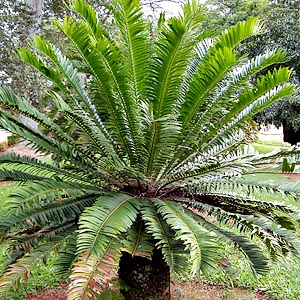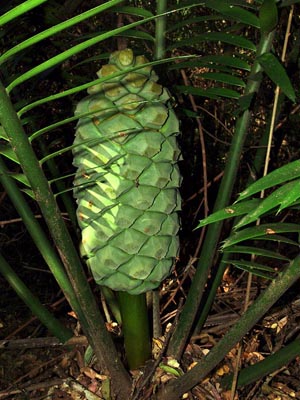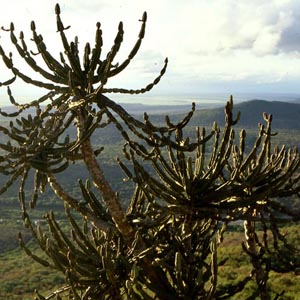Mlawula Nature Reserve: Flora - Priority Species
Information extracted from Southern African Plant Red Data Lists, Ed. Janice Golding, Southern African Botanical Diversity Network Report No. 14, 2002. The links for each species name go to the relevant pages of the Swaziland Flora Database.
Critically Endangered
Encephalartos striatus (E. mbuluziensis)
Status: CR A1acdA2cB1B2abcde Threats: Collection Distribution: Umbeluzi Gorge of Mlawula Occurs in the shade of Androstachys johnsonii forest. This species used to be extremely common, but this has changed. The species has suffered massive decline in the last 10 years, estimated at more than 80%. It is found in an extremely accessible area. Threatened by illegal collectors.
Euphorbia keithii
Status: CR A1cB1B2ab Endemism: Near endemic Threats: Urban expansion, habitat degradation Distribution: North of Mbabane (possibly Nkwalini landfill site) Found on rocky granite hills. Could be extirpated in the next five to ten years. Landfill site is a serious threat to locality, seriously threatened. The species is known only from this site in Swaziland.
Endangered
Aloe dewetii
Status: EN A1acd Threats: Collection Distribution: Hlatikulu (Grand Valley) Listed by WCMC’s RDL as Vulnerable for Swaziland and previously Rare. Previously found in the Hlatikulu (1970s), but could not be found there recently. Is a spotted leaf aloe eaten by people. Threatened by a high population density.
Encephalartos aplanatus
Status: EN A1acdB2abcde Distribution: Mlawula, Goba road just north of Siteki, South of Siteki toward the farm Muti Muti, previously on Muti Muti This species is also known from Mozambique. This species was described from a subpopulation of about six individuals near the Swaziland South Africa border. Subsequently, several subpopulations have been discovered. Threatened by illegal collectors.
Encephalartos lebomboensis
Status: EN A1acdeA2deB1B2abcde Threats: Harvesting, collection Distribution: Mangana, Mbuzini, Malto Alto, Lebombo, Stataweni, Mangana All the localities mentioned are primarily relicts. Subpopulations suffered a measurable decline. In 1981, the subpopulation was observed to be abundant. Almost 20 years later, there has been a 25% decline. Threatened by illegal collectors.
Lannea antiscorbutica
Status: EN DB1B2aC2b Endemism: Near endemic Distribution: Umbeluzi Gorge (Mlawula) Previously only known from a single locality in South Africa near the Swaziland Mozambique border.
Vitellariopsis dispar
Status: EN B1B2cD Endemism: Near endemic Distribution: Mlawula, Siteki Restricted. Only one locality outside Swaziland. Moist forest.
Vulnerable
Ficus polita subsp. polita
Status: VU D2 Distribution: Mlawula (Umbeluzi Gorge, Mahlabashane), Jilobi.
Gladiolus brachyphyllus
Status: VU A2c Threats: Urban expansion Distribution: Umbeluzi and Umlola Reserves, Mlawula Several subpopulations found in the Kruger National Park (South Africa); recorded from Limpopo Province and Mpumalanga (South Africa). Only single plants have been found in Swaziland. Very seldomly seen.





